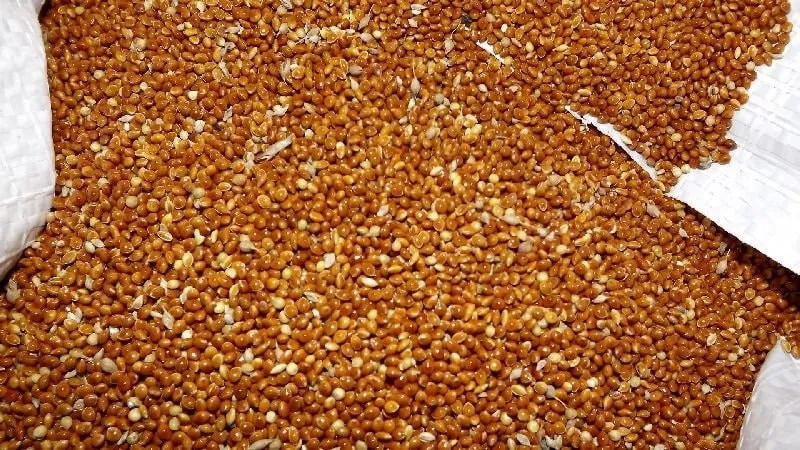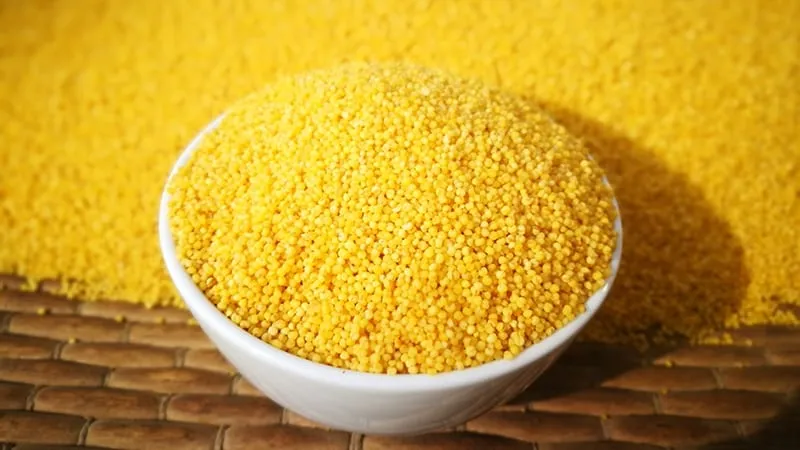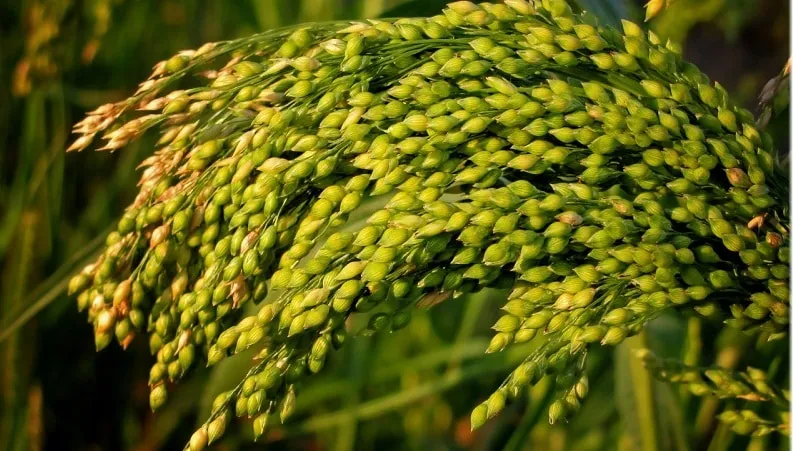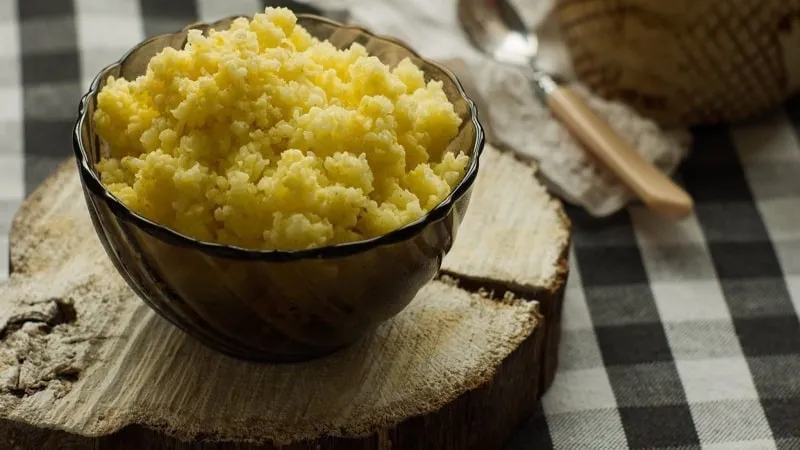Millet is considered the oldest cultivated cereal on the planet. This plant has been benefiting humanity for thousands of years, yet few know what it looks like or which grain is derived from it.
Photos, health benefits, uses of millet, and much more — below.
Table of contents
What Is Millet
Millet is a valuable food crop, an annual cereal. Thanks to its drought resistance, it is cultivated in many regions of the world with unfavorable farming conditions.
There are over 400 varieties of this cereal. Millet also grows wild as a weed.
What the Plant Looks Like and Which Family It Belongs To
Millet has several varieties, all similar in appearance.
Foxtail millet, or Italian millet, is grown as a fodder crop. Ornamental millet has beautiful purple leaves and is used as a hedge. In mountainous areas, wild millet — a weedy cereal — can be found.

Common millet, or proso millet (Panicum miliaceum), holds the most agricultural significance.
This is an annual herbaceous plant of the Panicum genus, belonging to the Poaceae family.
Millet has multiple stems forming a bush 0.45-1.5 m tall. The stems are cylindrical, hollow inside, with up to 10 nodes.
The leaves are linear-lanceolate, arranged alternately. They measure 18-65 cm in length and 1.5-4 cm in width. The color is green with a reddish tint.
The fibrous, well-developed root system penetrates the soil to a depth of over 1.5 m and spreads 1-1.2 m horizontally.
Millet forms panicle inflorescences 10-60 cm long, with 10-40 lateral branches. At the end of each branch are single-flowered spikelets 3-6 cm in size. The flowers are bisexual, with hard, glossy scales tightly enclosing the grain and falling off with it.
Depending on the inflorescence, common millet is classified into the following varieties:
- Spreading — with long, straight panicles producing golden-yellow grains;
- Loose — with long, open panicles;
- Compact — forming long, curved inflorescences;
- Oval — with short, straight, moderately loose panicles;
- Clustered — with short, straight, dense panicles.
The fruit of millet is a spherical grain up to 2 mm in size, colored white, yellow, red, or brown. These grains are processed into the cereal known as millet groats.
How and Where It Grows
Millet grains germinate at 8-10°C. The sprouts can withstand temperatures as low as -2°C. The plant tolerates heat up to +40°C. Millet is not demanding of moisture; in dry conditions, it pauses growth. Rainfall in the second half of summer benefits it, unlike other cultivated cereals.
The earliest mentions of millet cultivation date back to ancient China and the Caucasus in the 5th century BCE.
India is the leading producer, accounting for over 40% of global production. It is an important crop in China and African countries. In Europe, millet is grown in arid regions of Spain, Italy, and southern France.
Chemical Composition of the Cereal
Millet contains starch, proteins, fatty acids (oleic, palmitic, stearic, etc.), fiber, and essential amino acids.
Polished millet is rich in vitamins B1, B2, PP, and beta-carotene. The product contains almost all necessary trace elements (iron, copper, iodine, silicon) and macroelements (calcium, magnesium, potassium, sulfur, phosphorus).
Nutritional Value (per 100 g)
Per 100 g of dry cereal:
- Protein — 11.2-11.5 g;
- Fat — 3.3-3.9 g;
- Carbohydrates — 54.6-66.5 g;
- Caloric content — 298-342 kcal.
Nutrient content varies depending on the grain processing method.
Benefits and Risks
Consuming millet improves metabolism, boosts energy, and stabilizes the nervous system.
The high potassium and magnesium content makes millet dishes essential for cardiovascular health.
Iron accelerates blood production, making millet beneficial for preventing and treating anemia.
Millet is gluten-free, making it safe for those allergic to cereal proteins.
Millet is low in calories but provides long-lasting satiety, making it ideal for dietary and detox meals.
People prone to constipation should consume millet cautiously. It may also aggravate conditions like high stomach acidity, gastritis, or heartburn.
Note: Millet dishes are not recommended for children under three due to their heavy digestibility.
Types of Millet Groats
There are three types of millet groats, differing in processing methods:
- Hulled Millet — Only the outer husk is removed. This gentle processing retains most vitamins and minerals, making it the healthiest option. The grains are smooth and shiny but slightly bitter. It’s rare in stores.
- Polished Millet — The most common type, consisting of kernel grains with husks and germ removed. It has fewer nutrients than hulled millet. The grains are smooth, matte, and bright yellow.
- Crushed Millet — Made from ground polished millet. Cooks quickly, ideal for porridge.
- Storage Tip: Polished millet can turn bitter over time due to fat oxidation. Avoid bulk purchases. Choose clean, bright yellow grains free of debris.


Uses
Thanks to its high nutritional, mineral, and vitamin content, millet is widely used in cooking, cosmetics, traditional medicine, and agriculture.
In Cosmetics
Regular use of millet-based products moisturizes the skin, improves elasticity, and reduces signs of aging. Such creams and masks suit sensitive, allergy-prone skin.
B vitamins support hair follicle health. Millet extracts are used in hair growth stimulants and strengthening treatments.
In Agriculture
Millet is part of livestock and poultry feed, including grain, husks, and straw. It’s especially beneficial for young poultry.
Millet silage is more nutritious than barley or oat silage.
In Traditional Medicine

Many folk remedies use millet for kidney, liver, and cardiovascular conditions.
For blood pressure control, consume 3 tbsp of washed, dried, and crushed millet daily — either dry or as a decoction.
For pancreatitis, a dinner of millet porridge with pumpkin and olive oil is recommended.
Millet is a gentle diuretic. A water infusion (1 cup millet soaked in 3 L hot water for 24 hours) helps kidney function.
In Cooking
Millet has a distinct taste and aroma, unlike any other grain.
Porridge is the most famous millet dish — cooked with water or milk, sweet or savory, served with vegetables, meat, or dried fruits.
Crushed millet is used in soups, especially vegetable or fish-based ones.
Millet makes delicious casseroles with a unique flavor.
How to Cook Millet Porridge

Millet porridge is nutritious, hearty, and tasty. Every good cook has a favorite recipe. Choose bright yellow grains free of debris.
Below are versatile recipes adaptable to personal taste — e.g., replacing butter with olive oil or omitting sugar.
Basic Porridge (Water-Based)
Served as a main dish or side.
For 4 servings:
- Millet — 1 cup;
- Water — 2 cups;
- Butter — 2-3 tbsp;
- Salt — ¼-½ tsp (to taste);
- Sugar — 1-3 tbsp (optional).
Rinse the millet thoroughly (5-7 times), then scald with boiling water to remove bitterness. Add to boiling salted water with 1 tbsp butter. Simmer for 15-20 minutes, stirring, until thickened. Serve with melted butter and sugar if desired.
Milk Porridge
A perfect energy-boosting breakfast.
For 4 servings:
- Millet — 1 cup;
- Water — 2 cups;
- Milk — 2 cups;
- Butter — 2-3 tbsp;
- Salt — ¼-½ tsp;
- Sugar — 1-3 tbsp (or honey).
Rinse the millet until clean, scald with boiling water. Boil in salted water until absorbed. Reduce heat, add hot milk, and simmer for 10 minutes. Let stand covered for 5 minutes. Add butter and sweetener.
Pumpkin Millet Porridge
A healthy, sweet dessert option.
For 4 servings:
- Pumpkin — 1 kg;
- Millet — 1 cup;
- Milk — 2 cups;
- Butter — 2-3 tbsp;
- Salt — ¼-½ tsp;
- Sugar — to taste.
Dice the pumpkin. Rinse millet, soak in hot water for 5 minutes. Boil milk, add pumpkin, salt, and sugar. Stir in millet, simmer covered for 20-30 minutes. Serve with butter.
Conclusion
Millet is a cereal of great agricultural importance. Its drought and heat resistance make it ideal for arid regions. The plant has typical cereal features: narrow leaves, hollow stems, and fibrous roots. Its inflorescence is a panicle with spikelets. The round grains are processed into millet groats.
Millet porridge, with countless variations, holds a cherished place in European cuisine.
Rich in nutrients, millet is used not only in cooking but also in cosmetics, traditional medicine, and agriculture.







